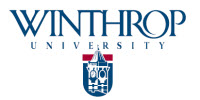Below is a summary of the abstract you submitted. Presenting author(s) is shown in bold.
If any changes need to be made, you can modify the abstract or change the authors.
You can also download a .docx version of this abstract.
If there are any problems, please email Dan at dar78@pitt.edu and he'll take care of them!
This abstract was last modified on June 5, 2019 at 7:31 a.m..

This is the 3rd year Winthrop University has offered a two-semester undergraduate research course as part of the SEA-PHAGES (Science Education Alliance-Phage Hunters Advancing Genomics and Evolutionary Science) program sponsored by the HHMI Science Education Alliance. During the fall 2018 semester, students focused on isolating and identifying unique bacteriophages using Microbacterium foliorum as the bacterial host. All samples were isolated from the North Catawba River Region. Individual phages were purified to obtain identical plaque morphologies and then amplified to collect high viral titer (HVT) lysates. Phage DNA was isolated and cut using restriction enzymes in tandem with a Phage Enzyme Tool (PET). DNA gel electrophoresis was used to display the DNA fingerprints of the individual phages; their patterns were then uploaded onto the PET program to predict the cluster of a phage. Two phages with high titer lysates and unique restriction digest patterns; Rhysand and MonChoix, were sent to the University of Pittsburgh for DNA sequencing. The genome annotations were performed at Winthrop University, Rock Hill, SC. Rhysand is a member of the EE cluster and contains 25 open reading frames. Its genome is 17,453bp in length with a GC content equal to 68.7%. We identified a -1 frameshift in the tail assembly chaperone proteins which is characteristic of all other annotated members of the EE cluster. MonChoix is a member of the EA cluster, and a member of the EA1 sub-cluster. MonChoix has 63 open reading frames and is 41,670bp in length, with a GC content equal to 63.4%. Members of the EA1 sub-cluster are not known to contain frameshifts in the tail assembly chaperone proteins, in contrast to other members of the EA cluster. To investigate host range, these phages as well as a previously characterized WU microbacterium phage, Scamander, were tested to see whether they have the ability to infect other bacteria from the Actinobacteria phylum. The hosts include Microbacterium liquefaciens, Microbacterium paraoxydans, and Microbacterium testaceum. Initial spot titers showed signs of plaque formation on alternative hosts by two of the 16 phages. To date, Scamander and Rhysand appear specific for their host and MonChoix exhibits a wider host range. Comparative analysis at the genome level and further testing phenotypically will help elucidate whether these newly discovered phages use a specific host to replicate, whether we are observing abortive infection on alternative hosts or whether mutants exist that have the advantageous ability to infect a variety of bacterial hosts in their microbial community. This work adds to the increasing knowledge of bacteriophage biology and host-phage evolution, which is also relevant to the control of bacterial infectious disease.

